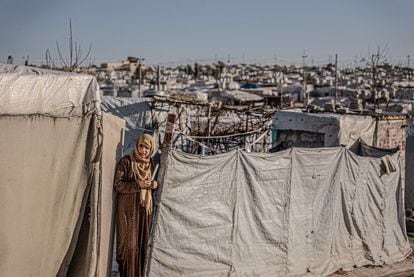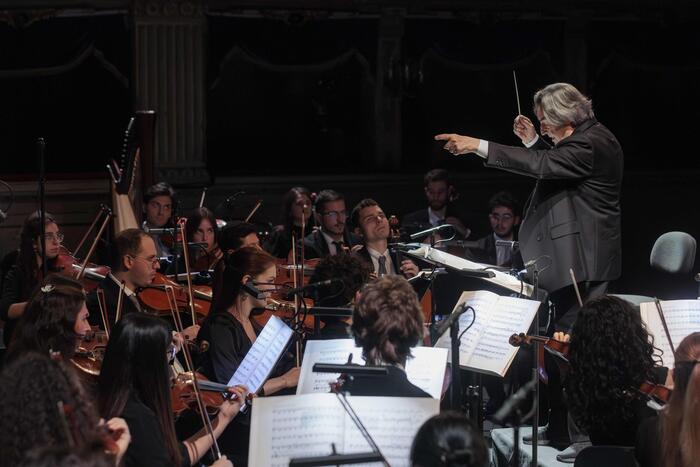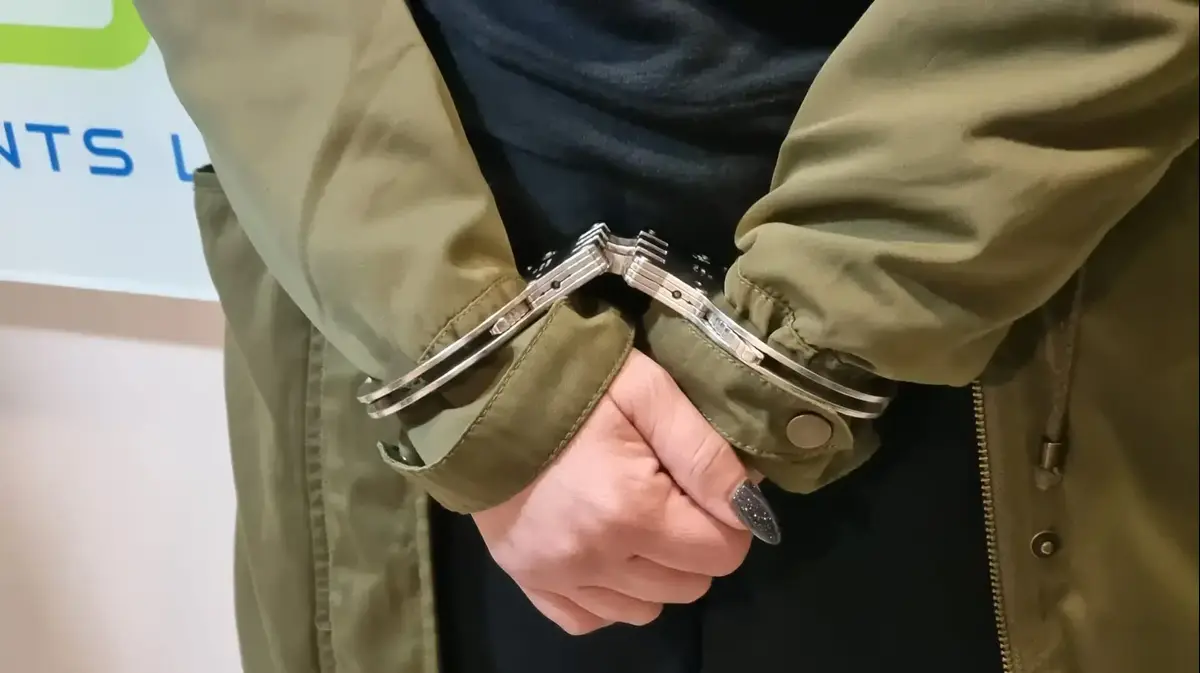In the early hours of August 2-3, 2014, Falah Hassan's cell phone rang.
He was awake.
In the city of Janesor (in the northwest of Iraq) no neighbor slept.
It does not fall asleep if the Islamic State is advancing towards your house.
“They're coming in,” said a voice on the other end of the phone as Falah picked up.
"Flee."
Falah, Yazidi, 31 years old, a musician, married and with a months-old baby, hurriedly grabbed some water and food, told his neighbors and got into his
pickup truck
.
“In the middle of the darkness we could hear gunshots and explosions.
The sky lit up every few minutes,” says Falah himself.
It was like the advance of the monster that you cannot see.
Falah speaks from an apartment in the Iraqi town of Duhok, where he has gone to tell about his experience.
He has left his duties as a musician for one day because he wants to share his story.
"Hundreds of vans were leaving from all the surrounding towns," he continues.
The direction of all was the same: the mountain.
Neighbors stampeded out, clogging the only road.
With the jihadists only a few hundred meters away, many abandoned their vehicles and began to run up the slope as the unwelcome sun rose.
Dalkhil Garo, Yazidi, writer and poet, 44 years old, was one of those who had to get out of his van with his family after rushing out of his village.
“From that moment I remember seeing pregnant girls crawling, they couldn't move forward.
And we weren't able to help everyone."
The shots began to reach some neighbors, the hillside began to be populated with bodies.
“I have no words to describe that scene.
Children lying on the ground, screaming, shooting… I have no words”, says Dalkhil.
"And that I am a writer," he adds with a grimace, as if trying to make the joke contain the tears that are already appearing.
goal number one
There are two things that Yazidis love: billiards and music.
There is no Yazidi home that does not contain an instrument and no place of leisure where a pool table is not to be seen.
And in both places they are usually singing.
The history of the Yazidi people can be written like a symphony.
“For the Yazidis, culture is a fundamental element.
Literature, music, education… It is something that is always present”, explains Gani Mirzo, a Kurdish musician of Yazidi origin who has lived in Barcelona for decades and has opened a music school in Janesor
to support child survivors of the genocide.
“And precisely because of that closeness to music and culture, they became the number one target of the fans, the most hated people that had to be exterminated.”
Gani Mirzo plays the lute in Sinjar Cathedral.Pablo Tosco
The Yazidis are a Kurdish minority.
Kurds inhabit much of southern Turkey, northern Syria and Iraq, and parts of western Iran.
Its territory represents a continuum not recognized as a State that has always been repressed and threatened by the governments of the day.
In the case of Iraq, and after the fall of Saddam Hussein's regime, the Kurds achieved autonomy that has turned them into a
de facto
state , with their own army (
Peshmerga
), institutions and Parliament.
It is here, in the Sinjar region, that most of the Yazidis live.
It is a mountain range that stands in the middle of the desert and where almost half a million Yazidis are distributed in 81 cities, towns and villages.
There are also Sunni Arab towns in the area, a tense relationship that ended up transforming neighbors into collaborators.
What makes the Yazidis a minority among the Kurds is their religion.
Yazidism is a pre-Islamic faith that descends from Zoroastrianism and whose story remains outside of Abrahamic beliefs (Islám
,
Christianity and Judaism).
Some pagans in the eyes of the Islamic State elevated to the category of worshipers of Satan.
Actually, for the Yazidis, this story is not new.
The conviction on the part of other religions that they are worshipers of the devil (in the Yazidi story, one of the seven angels they believe in disobeys God, thus becoming the fallen angel for some interpretations) has dragged them into repression. and slaughters.
Even by the rest of the Kurds, mostly Muslims.
According to Yazidi tradition, their people have suffered 74 genocides throughout history.
The last one, at the hands of the Islamic State in 2014.
The attack
"If they have faith in God and work well, they will rule the earth as God has promised to believers."
It was one of the phrases that Al Baghdadi, then leader of the Islamic State, spoke in his speech on June 29, 2014 in Mosul.
On that day, the ISIS leader proclaimed the caliphate and called on all Muslims to join him and wage jihad.
They were only 100 kilometers from Sinjar, the region of the Yazidis.
The advance of the terrorist group -already converted into an army- had the purpose of conquering territory, erasing the border between Iraq and Syria and converting all the inhabitants to Sunni Islam.
In the case of the Sinjar region there was an added objective: to exterminate the Yazidis.
It was Abu Ibrahim al Hashemi al Quraishi who legitimized the massacre with a twisted interpretation of Islam.
The ideologue of the genocide would end up being, years later, the leader of the Islamic State.
The United States eliminated it on February 3.
Having prepared the ground, and after arming themselves to the teeth thanks to several abandoned US military bases in the area, the jihadists advanced in a pincer pattern on the Sinjar region.
The
peshmerga
, the Iraqi Kurdish army, withdrew unable to cope with the advance and left the neighboring Yazidis defenseless, who still today remain unforgiving of this abandonment.
Neighboring Sunni Arabs, out of conviction or terror, joined the invaders and guided them through the region, pointing out Yazidi villages and houses.
The first town they reached, in the early hours of August 3, was Siba Sheikh Khader.
Falah Hassan's uncle lived there, who picked up his cell phone and called his nephew: “They are entering.
Flee.”
The human hunting ground
In a stampede, thousands of Yazidis rushed to the mountain in the early hours of August 3, as ISIS militias entered towns and villages.
For centuries the mountain has symbolized salvation for the Yazidis.
Dozens of massacres later, each family knows, like a mantra handed down from generation to generation, that if there are problems, the mountain is the refuge.
To the mountain the Halo family fled.
Today they live in the Janki refugee camp, on the outskirts of Duhok.
They have been here since 2014, when the attack took place.
They receive us in their tent and it is Ranna, the eldest daughter, who speaks.
She is, of course, passionate about music and she plays the
daf
, a regional instrument very similar to the tambourine, but larger.
"That day I think it was 45 degrees," she explains.
"Our family took shelter among some rocks, but there was no shade."
Within a few hours, almost all of Ranna's village was out of the sun and dressed.
“What I remember most is the cries of the children.
She never stopped,” she says.
She then takes out her cell phone and shows us a song she has composed for a friend who couldn't get over the suffocating heat.
Music always present.
At another point on the mountain, also surrounded by thousands of people on the verge of dehydration, was Daljil, the poet, with his family.
In reality, the entire Sinjar mountain range became in a few hours a huge hunting ground with thousands of Yazidis in hiding and ISIS units looking for them.
"We spent eight days in a remote area, at ground level," he relates.
“During the day we suffocated and at night we were very cold.
New corpses appeared every day.
Especially older people and babies.
The image of the children's bodies covered with stones, like a tomb, has remained engraved in my mind.
Most died of thirst.
Our genocide was by thirst.”
A woman in the Janki refugee camp.Pablo Tosco
Some neighbors improvised control and defense posts, with homemade shotguns, to prevent ISIS from reaching the areas where the families were taking refuge.
“We lived like fawns surrounded by lions.
We were terrified, we couldn't sleep.
Many people committed suicide.
They did it when ISIS arrived, before they got caught,” says Daljil.
“Part of my family had not managed to escape.
I managed to talk to them on a cell phone and they told me that they were locked in a house, hidden, in silence.
They gave the babies adult tranquilizers so they wouldn't cry."
One of those families that did not have time to flee was that of Hachi Baberad, 55 years old, known to all as Abu Rahad.
He currently lives in the Yazidi refugee camp in Isyan, where he tells us that his 19 children and his grandchildren were kidnapped.
“Everyone”, he affirms with a small voice.
From that day until today his life consists of raising money to pay for his release.
He has already shelled out $170,000 in ransoms, which he raises through donations and pays to smugglers working for the Islamic State.
He still has seven kidnapped sons and daughters.
The scene as dawn broke on August 4 was dystopian: some 50,000 Yazidis were hiding in the mountains under the unbearable sun while thousands of jihadists tried to hunt them down.
When they captured a family, they beheaded the men or burned them alive and took the children and women.
That day, in the Baghdad Parliament, the Yazidi deputy Vian Darkhil, in a torn speech between tears, asked the Iraqi government and the whole world for a reaction: “A genocide is taking place.
This is for humanity, help them!”
On August 7, the United States, then headed by Barack Obama, admitted that what was happening in Sinjar was genocide.
The next day I send drums of water and food that several planes dropped from the air.
“As the days passed, the dead accumulated.
Every morning there were funerals.”
Fahad Harbo, 25, a music teacher from Til Ezzer, a town in the Sinjar region, takes the floor.
He and his family took refuge under a tree for 11 days.
“Our grandparents and parents spoke of the 73 attempted genocides, but they had never suffered such pain, such extreme cruelty.
The barbarities they committed...”, says Fahad.
“Thousands were arrested.
Small children were shot in the head.
They beheaded the others.
He constantly thought: 'this is the end'.
I thought about turning myself in and being killed by ISIS, that would end it all."
He resisted thanks to a puddle in the sun from which all the hidden neighbors drank and a small house with a garden whose owner gave them some vegetables.
“No one is helping us,
The siege of Sinjar lasted two weeks, until the survivors managed to leave the region thanks to a humanitarian corridor opened by the Popular Protection Units (YPG, in Kurdish), the Syrian Kurdish forces, with the support of the United States.
Then there was an exodus, a caravan of starving and terrified figures, headed for the city of Duhok.
The 160-kilometre desert crossing is recalled by Pir Alo, director of the Janky refugee camp.
“It was like watching a zombie procession.
Thousands of people in silence, covered in sand and dust, devastated by thirst.
They left behind, according to United Nations data, 5,000 Yazidis murdered in just two weeks.
A massacre of more than 300 murders a day.
Almost 6,000 hostages, most of them children and women, completed the balance of the human hunt.
A genocide that the Spanish Parliament has not recognized.
The only initiative was presented in 2017, but it vanished in 2019 with the change of government.
No parliamentary group has spoken since then, unlike the European Parliament, France, the United Kingdom, the Netherlands or Germany, which do recognize and condemn the genocide against the Yazidis.
The cruelest story possible
More than 1,300 Yazidi women remain kidnapped and 350,000 people are today displaced from their homes after the genocide.
His drama, that of women and children, has an added tragedy.
“I don't think there has ever been anything crueler in history than what has happened to us Yazidis.
I have seen how mothers were fed the meat of their babies that they had killed.
I've seen the most horrifying things you can imagine."
Seerin speaks in a whisper.
The expression on his face, even when he relaxes or smiles, is that of someone about to burst into tears.
Her trauma is with her, and yet she agrees to recount her experience, which is, in reality, that of the more than 3,500 Yazidi women kidnapped after the Islamic State attack.
The mountain hideout of Seerin and his family was discovered by a group of jihadis within days.
She was pregnant, her husband, her three children and her daughter were put on a truck and taken to Tal Afar, where they stayed for nine months in an abandoned school, forced to convert to Islam.
Seerin gave birth and she almost died in childbirth.
With her newborn daughter and another seven year old, she was separated from the others.
"That was the last time I saw my husband," she says.
They were transferred to Mosul.
"There they sold me to a man named Abu Ahmed, who took me to Syria."
Like so many other women, Seerin was auctioned off in a market, with a price tag on her.
During those years, the Islamic State developed a network of buying and selling women and girls, with gynecologists who checked them to certify their virginity, forced abortions, social media channels where offers were made, and property titles.
“This man took us to Raqqa and there we worked in his house, together with his family.
And he tortured us, ”he explains, looking at the ground.
"He also tortured my baby."
Fahad Harbo shows the photos of his family found among the ruins of his house in Tel Ezzir.Pablo Tosco
Months later, Seerin and her daughters were sold to a Saudi based in Syria, where the torture continued.
"Once she punished me and I was tied to a tree for a month."
In 2018, she was separated from the girls and released thanks to the payment of her brother, who brought her back to Iraq.
“My daughters are still kidnapped today.
They are in the Al Hol camp, in Syria.
They have sent me photos, but I have no money to pay for their release and the Kurdish authorities cannot release them because they have no papers.”
She later adds: “They themselves, after so many years, do not recognize me as a mother.
She has brainwashed them.”
Seerin holds back tears.
Next to Seerin, in the tent of the refugee camp where he has lived since his liberation, are Mofid and Fahad, his two sons, aged 16 and 19.
They were taken by ISIS to Baghuz, an Islamist stronghold in Syria and a training camp.
“Fahad, the oldest, was forced into combat.
And he lost a leg,” explains Seerin.
Opposite, Fahad touches the stump and explains that the other leg keeps losing muscle mass.
"I should have surgery," he says.
"But nobody can here, they say I have to do it in Europe."
Then he smirks.
"I don't have money to go to Europe."
Mofid and Fahad were kidnapped for almost seven years.
“When they were released,” says Seerin, “they didn't want to go back.
They were convinced they were part of ISIS.”
Nor is this exceptional.
Many Yazidi youth abducted as children must start over and face stigma from their own community.
Most mothers are forced to choose: stay in the prison camps with their children or return alone.
the impossible return
Almost none of the survivors of those days of terror dare to return home.
Yazidis call August 3, 2014 the
farman
, the genocide, and many of them have the date tattooed on their arms.
Fahad Harbo, Til Ezzer's music teacher, did return.
He did it two years ago to a devastated region, with hundreds of empty towns and where bodies continue to appear in the mountains.
Where they have found 73 mass graves and where, still today, they remove corpses from the water wells into which the Islamic State threw them to intoxicate the population.
Fahad rebuilt his house and decided to start over.
He today runs a school where boys and girls fight to leave trauma behind through music.
"Everything stopped in 2014, but I didn't give up music."
Others, like the writer and poet Dalkhil, remain in refugee camps with no possibility of return.
“I am ashamed that tomorrow my children will blame me for raising them in a tent,” he says.
Later, with night already falling on the field, he reviews some of his writings and recites one of his poems before the eyes of his family and friends, who remain in deathly silence:
I am a flock of birds
Flight
I become a refugee
I run out of wings
One by one I die.
Follow all the international information on
and
, or in
our weekly newsletter
.
Exclusive content for subscribers
read without limits
subscribe
I'm already a subscriber



/cloudfront-eu-central-1.images.arcpublishing.com/prisa/U2R7NZPI4CFAXSB3RA5IFUE2VE.jpg)

/cloudfront-eu-central-1.images.arcpublishing.com/prisa/V2NVVLWUXVPFJKDMYZQLB5BFYA.jpg)



